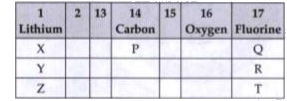The arrangement of metals in a vertical column in the decreasing order of their reactivities is called the reactivity series or activity series of metals. The most reactive metal is at the top position of the reactivity series. The least reactive metal is at the bottom of the reactivity series.
Hydrogen, though a non-metal, has been included in the activity series of metals only for comparison. Apart from it, the hydrogen atom also has tendency to lose its valence electron and form cation like the behaviour shown by metals. Thus,
H→H++e−
Which metal can be displaced by copper from in salt solution ?
Zinc
Silver
Iron
Lead
The correct Answer is:B
To determine which metal can be displaced by copper from its salt solution, we need to refer to the reactivity series of metals. The reactivity series ranks metals based on their ability to displace other metals from their compounds in solution.
1. Understand the Reactivity Series: The reactivity series is a list of metals arranged in order of decreasing reactivity. Metals higher in the series can displace metals lower in the series from their compounds.
2. Identify the Position of Copper: In the reactivity series, copper is positioned below hydrogen. This means that copper is less reactive than metals above it, such as iron, zinc, and aluminum.
3. Determine Metals that Can be Displaced by Copper: Since copper is less reactive than metals like iron and zinc, it cannot displace these metals from their salt solutions. However, it can displace metals that are lower in the reactivity series than itself.
4. Identify Metals Below Copper: The metals that are less reactive than copper include silver (Ag) and gold (Au). Therefore, copper can displace these metals from their salt solutions.
5. Conclusion: The metal that can be displaced by copper from its salt solution is silver (Ag).
Final Answer:
Copper can displace silver (Ag) from its salt solution.
---
Copper can displace silver (Ag) from its salt solution.
Topper's Solved these Questions
- BOOK - MTG IIT JEE FOUNDATIONCHAPTER - METALS AND NON METALS EXERCISE - Exercise (Subjective Problems) Very Short Answer Type15videos
METALS AND NON METALS
- BOOK - MTG IIT JEE FOUNDATIONCHAPTER - METALS AND NON METALS EXERCISE - Exercise (Subjective Problems) Short Answer Type15videos
METALS AND NON METALS
- BOOK - MTG IIT JEE FOUNDATIONCHAPTER - METALS AND NON METALS EXERCISE - Exercise (Assertion & Reason Type )10videos
METALS AND NON METALS
- BOOK - MTG IIT JEE FOUNDATIONCHAPTER - FOOTSTEPS TOWARDS CBSE BOARDEXERCISE - SECTION - C39videos
FOOTSTEPS TOWARDS CBSE BOARD
- BOOK - MTG IIT JEE FOUNDATIONCHAPTER - MOLE CONCEPT, STOICHIOMETRY AND BEHAVIOUR OF GASES EXERCISE - EXERCISE (INTEGER/NUMERICAL VALUE TYPE)5videos
MOLE CONCEPT, STOICHIOMETRY AND BEHAVIOUR OF GASES
Similar Questions
Knowledge Check
- Question 1 - Select One
The arrangement of metals in a vertical column in the decreasing order of their reactivities is called the reactivity series or activity series of metals. The most reactive metal is at the top position of the reactivity series. The least reactive metal is at the bottom of the reactivity series.
Hydrogen, though a non-metal, has been included in the activity series of metals only for comparison. Apart from it, the hydrogen atom also has tendency to lose its valence electron and form cation like the behaviour shown by metals. Thus,
H→H++e−
The most reactive metal isAPotassiumBbariumCsodiumDcalcium. - Question 2 - Select One
The arrangement of metals in a vertical column in the decreasing order of their reactivities is called the reactivity series or activity series of metals. The most reactive metal is at the top position of the reactivity series. The least reactive metal is at the bottom of the reactivity series.
Hydrogen, though a non-metal, has been included in the activity series of metals only for comparison. Apart from it, the hydrogen atom also has tendency to lose its valence electron and form cation like the behaviour shown by metals. Thus,
H→H++e−
The only non-metal involved in activity series of metal isAsulphurBchlorineChydrogenDmagnesium. - Question 3 - Select One
The arrangement of metals in a vertical column in the decreasing order of their reactivities is called the reactivity series or activity series of metals. The most reactive metal is at the top position of the reactivity series. The least reactive metal is at the bottom of the reactivity series.
Hydrogen, though a non-metal, has been included in the activity series of metals only for comparison. Apart from it, the hydrogen atom also has tendency to lose its valence electron and form cation like the behaviour shown by metals. Thus,
H→H++e−
An element 'X' after reacting with acids liberate hydrogen gas and can displace lead and tin from their salt solution. The metal 'X' isAcopperBgoldCnickelDhydrogen.

Which is the most reactive metal ?View SolutionName the least reactive metal.
View SolutionThe arrangement of metals in a vertical column in the decreasing order of their reactivities is called the reactivity series or activity series of metals. The most reactive metal is at the top position of the reactivity series. The least reactive metal is at the bottom of the reactivity series.
Hydrogen, though a non-metal, has been included in the activity series of metals only for comparison. Apart from it, the hydrogen atom also has tendency to lose its valence electron and form cation like the behaviour shown by metals. Thus,
H→H++e−
The metal which does not liberate hydrogen gas after reacting with acid isView SolutionWhich is most reactive metal
View SolutionThis is the least reactive metal in the metal activity series.
View Solution
